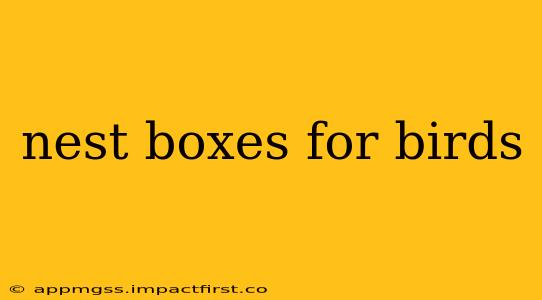Want to attract a vibrant array of birds to your garden? Providing nest boxes is a fantastic way to do just that! These artificial nesting cavities offer safe havens for birds, particularly those facing habitat loss or a shortage of natural nesting sites. This comprehensive guide will explore everything you need to know about choosing, installing, and maintaining nest boxes to successfully attract feathered friends.
What types of birds use nest boxes?
Many bird species will readily utilize nest boxes, but the type of box needed varies greatly depending on the species you're hoping to attract. Smaller species like chickadees and wrens require smaller entry holes, while larger birds like wood ducks need much larger openings. Researching the specific birds in your region and their nesting preferences is crucial for success. Common users include:
- Wrens: These tiny songbirds thrive in smaller boxes with smaller entry holes.
- Chickadees: Similar to wrens, they prefer compact boxes.
- Titmice: Another small bird species that appreciates well-protected nest boxes.
- Bluebirds: These cavity nesters require boxes with specific dimensions and entrance hole sizes.
- Kestrels: These small falcons need larger boxes with wider entrances.
- Wood Ducks: These ducks need much larger boxes with a special access point near the water.
What size nest box should I use?
The size of the nest box is paramount. Too large, and it might attract predators; too small, and it won't suit your target species. Consider these factors:
- Species: Research the specific dimensions recommended for the bird species you hope to attract. Online resources and bird guides offer this information.
- Entrance Hole Size: The size of the entrance hole is critical to deter larger predators while still allowing the target species easy access.
- Box Dimensions: The internal dimensions should provide sufficient space for the birds to nest comfortably, laying eggs and raising their young without feeling cramped.
Where is the best place to put a bird nest box?
Placement significantly impacts the success rate of your nest box. Consider these vital factors:
- Height: The optimal height varies depending on the species, but generally, placing the box at least 6 feet high helps deter ground predators such as cats and raccoons.
- Location: Position the box in a sheltered location, away from direct wind and rain. Facing it away from prevailing winds is ideal.
- Sunlight: Partial shade is preferable; avoid placing the box in full sun, which can overheat the interior, especially during hot summer months.
- Nearby Trees and Cover: Locate the box near trees or shrubs that offer a safe passageway for birds to approach and depart.
- Predator Protection: Position the box strategically to minimize the risk of predation, such as avoiding areas with overhanging branches where predators can easily access the box.
How do I clean a bird nest box?
Cleaning bird nest boxes is essential for maintaining a hygienic environment and preventing the spread of disease. However, it's crucial to do this only during the off-season, typically in late fall or early winter, when birds are not actively using the boxes.
When should I put up a nest box?
Ideally, you should install nest boxes in late winter or early spring, before the breeding season begins. This gives birds ample time to find and inspect the boxes before starting to build their nests.
What materials should I use to build a bird nest box?
Untreated wood is the best material for bird nest boxes. Avoid using pressure-treated lumber, as the chemicals can be harmful to birds. Cedar or redwood are excellent choices due to their durability and resistance to rot.
How do I make a bird nest box?
You can easily build your own nest box following detailed online instructions or plans. Many websites and videos offer step-by-step guides with diagrams and materials lists. Ensure you use appropriate tools and follow safety precautions while building.
Do I need to provide nesting material?
Generally, providing nesting material is unnecessary. Birds usually gather their own preferred materials. However, if you notice birds struggling to find suitable material, you can consider providing a small amount of soft material such as shredded bark or small twigs near the nest box.
By following these guidelines, you can greatly increase your chances of successfully attracting birds to your garden and enjoying their presence. Remember that patience is key; it may take time for birds to discover and utilize your new nest boxes. Happy birding!
